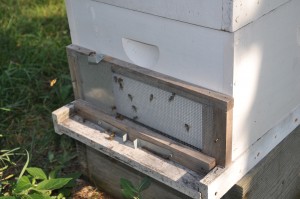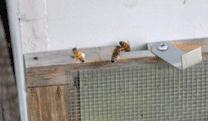Yes, our honey bees can become little criminals and steal from their neighbors! Their larceny is usually not much of a problem in the spring and early summer when a good nectar flow is on. But be alert! As the flow slows or stops, as is now occurring, bees are on the lookout for any source of food they can find. The closest source might be their neighbors’ hives. Weak hives (hives with decreased numbers of bees), new nucs or divides, recently captured swarms – any hives that have not built up well or which are dwindling due to disease, pests, or other causes – are likely targets of robbing bees. Heavily robbed hives can face starvation very quickly, so beekeepers need to be observant to prevent or reduce this activity. The culprits may come from your own hives, from your neighbor’s, or from nearby bee trees.
A robbing response can also be triggered by beekeepers while working hives or removing honey supers at this time of year. Supers of honey, or even open brood boxes exposed in the bee yard, can be all the temptation that’s needed to initiate the behavior and, once begun, it quickly escalates. Try to go through hives quickly or cover boxes that are set off hives. When removing supers, take them out of your apiary as quickly as possible and keep them well covered if left temporarily outside. If you set wet supers out after extraction to allow the bees to clean out the remaining honey, do so at least several hundred feet away from your hives. Also, set them out late in the day to lessen the time for potential robbing. Better yet, set wet supers back on top of the hives (only on strong hives) and allow the bees to clean up the remaining honey within the hive. This should be done late in the day as well. Always keep an eye on your hives whenever you have exposed honey so that, if robbing begins, you can attempt to do something about it.
Open feeding, which is feeding entire bee yards by putting sugar syrup out in an open barrel or bucket (with straw or wood floats inside), very often instigates robbing. If you practice open feeding (WHICH I DO NOT RECOMMEND), first install entrance reducers in ALL of your hives and place the feeding bucket or barrel a couple of hundred feet from your apiary. (Remove the entrance reducers from stronger hives after feeding is finished.) Open feeding, or exposing honey, can cause even strong colonies to be robbed. Another argument against open feeding, especially at this time of year, is that you are very likely feeding, not just your own bees, but all the hives within a couple of miles, including feral colonies.
What can you do to prevent, slow, or stop robbing? You can install entrance reducers in weak hives and nucs at the end of the nectar flow, prior to any signs of robbing. Reducers restrict access to the hive and will often prevent robbing or slow it down once it has begun. For even better results, consider using an anti-robbing screen. This is a specially constructed screen that is placed in front of the hive entrance, leaving a small opening directly over it, but closing off the front entrance. (The screen shown is manufactured and sold by Brushy Mountain Bee Supply – the only one I’ve found for sale. If anyone knows of others, let me know. Fortunately, they are easy to make with some #8 hardware cloth, and many beekeepers do so.

At left – Anti robbing screen in place on hive.
Closeup of the screen’s top entrance at right.
The key to the screen’s success is the top entrance. The bees inside the hive quickly figure out where the new entrance is and use it to go in and out of the hive. Robbing bees will continue to come to the screened front of the hive and seek entrance there, to no avail. A Virginia beekeeper friend who has used such screens for years told me the robbers only want to enter straight ahead, not up and down. I don’t know if that is a factor – I just know that they work. Besides being more effective than regular entrance reducers, these screens do not reduce air flow through the hive. This is a very important factor in hot weather.
To stop robbing that is already underway, you can also temporarily seal the entrance completely. Burlap placed in the entrance works well for this. Grass can be a substitute, but bees will remove grass fairly quickly. Remember to reopen the entrance at the end of the day, after the bees stop flying. When robbing is interrupted, it usually does not resume the next day, but install an entrance reducer or anti-robbing screen, just in case, when you open the entrance back up.


Pingback: Mid-summer hive inspections, they are important | Phil Craft Hive Craft